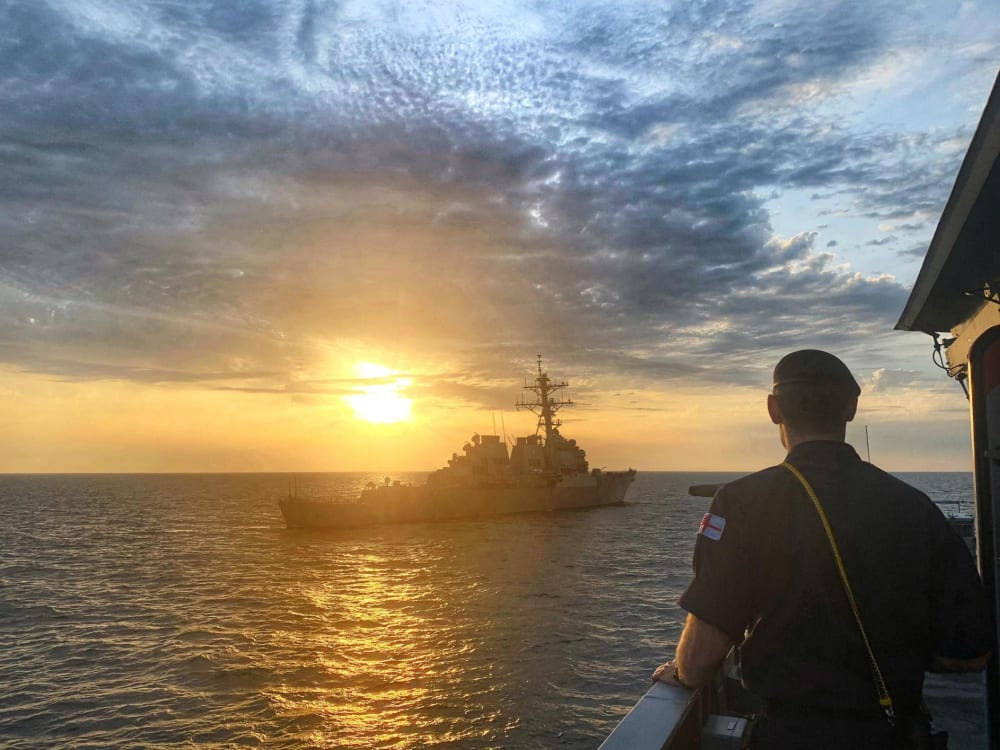
The U.S. and Ukrainian navies wrapped up Exercise Sea Breeze 2021 July 10 in the Black Sea region.
“We’ve had the largest Sea Breeze since we began over 20 years ago,” said Capt. Stuart Bauman, the Sea Breeze 21 exercise director on the U.S. side during a press conference on Friday. “We’ve had the participation of 30 nations including observers and mentors; more than 5,000 Sailors, Soldiers, and Airmen; more than 40 aircraft participate; 32 ships and just a great amount of cooperation and partnership between all of the nations.”
Bauman said there was great participation from both NATO and non-NATO participants across a wide variety all around the globe, including Asia, Africa, North America, Europe, and the Middle East. “We had great participation from a wide variety of countries. We had folks come in to be mentors with the Ukrainian forces, we had teams participating in our diving exercises as well as being observers and across all of the different air, land, and maritime components.”
Participating Sea Breeze 21 nations included Albania, Australia, Brazil, Bulgaria, Canada, Denmark, Egypt, Estonia, France, Georgia, Greece, Israel, Italy, Japan, Latvia, Lithuania, Moldova, Morocco, Norway, Pakistan, Poland, Romania, Senegal, Spain, South Korea, Sweden, Tunisia, Turkey, Ukraine, United Arab Emirates, United Kingdom and the United States.
“The level of cooperation and integration is at its highest level that we’ve seen, and the Ukrainians are very capable as well as all of the partners that have joined in,” Bauman said. “And we’ve covered everything from maritime components to air, to land to special operations.”
Bauman said the forces took part in sea, air and land warfighting scenarios. “We had quite a bit of interoperability between many different nations across all of the domains of warfare, and they’ve all done an outstanding job.”
Cmdr. John D. John, commanding officer of Rota, Spain-based USS Ross (DG-71), said he and his crew were part of a five-ship battle group that incorporated a Ukrainian vessel, Hryhoriy Kuropiatnykov, the Bulgarian ship Bodry, the British ship Trent, and Romanian ship Macellariu. “Our mission has been to promote interoperability and enhance warfighting readiness for our collective of the Black Sea region to ensure safety and prosperity in this region for allies and partners.”
John said Sea Breeze enhances combat readiness amongst participating NATO and allied partner nations to rapidly respond to any threats. “I believe that we proved that our ability to seamlessly operate together to maintain a stable and prosperous Black Sea region sends a message to the world that we are committed to enhancing stability and deterring aggression. No nation can confront today’s challenges alone, and the Black Sea is no different. While it may be smaller than other international bodies of water, it’s still quite large and provides an appropriate area for nations to come together to learn from each other, strengthen relationships, and also contribute to each other to ensure the continued success of the longstanding alliance with NATO and our partner nations.”
John said the exercise took place in international waters in the Black Sea, and therefore there was the opportunity for both non-participating units and civilian vessels to be in and around the exercise area. “From all accounts, all vessels and aircraft participated or conducted themselves in accordance with international law and maritime regulations and with due regard for safety.”
“As professional mariners, regardless of what nation, safety at sea is paramount for all vessels,” John said. “There were at least two interactions over bridge-to-bridge VHF radio communication where both a non-participating unit and a participating unit communicated with each other effectively and professionally to ensure safe navigation of the exercise area. All of those communications were conducted in a routine and professional manner.”
U.S. Marine Corps Lieutenant Colonel Mastin Robeson, Jr., the commander of 1st Battalion, 6th Marines, was speaking from Oleshky Sands in Kherson Oblast, Ukraine, collocated with the 88th Marine Infantry Battalion as well as the 1st Separate Battalion, Airborne Marines. “I’ve got with me approximately 400 Marines from across the 2nd Marine Expeditionary Force, also known as II MEF. And our mission was to deploy from Camp LeJeune, North Carolina to Oleshky Sands to conduct training with other nation forces, to include Ukrainian marines, Georgian soldiers, as well as Moldovan forces.”
Robeson said the exercise consisted of multiple phases. “The first phase was an opportunity to really get familiar with the other services that we were working with from other nations. We had a transition period on the 4th of July where we paused to celebrate Naval Forces Day for the Ukraine and, of course, Independence Day for the United States, and then we moved into a final exercise.”
“The exercise has been a great experience for the Marines from 1st Battalion, 6th Marines and those from II MEF that accompanied us out here. The opportunity to operate in an expeditionary environment where we’re living in tents and out training with partner forces who maintaining stability in the Black Sea is a great win for us and I think a great win for the partners we worked with. We found that our partner forces are professionals, skilled, and have a lot of pride in what they do. We had the chance to work with equipment and folks we don’t work with every day,” said Robeson. “It was a great opportunity to exchange esprit de corps between the nations. And for the record, we had a lot of rain out here the whole way through it.”

During the exercise, U.S., Ukrainian, Canadian, Polish and Georgian divers worked together to remove a civilian vessel that sunk in 2016 that was blocking a portion of the Odessa Port pier. Officials said the cooperative dive and salvage operation demonstrated the tangible lasting impacts the partnerships between participants as well as increasing port access and maritime safety.
During the press conference, reporters asked Bauman if Sea Breeze was a sign of increased NATO or American deployments in the Black Sea in the future. “Sea Breeze is just one of many exercises that we conduct both around the world and in Europe and the Black Sea region,” he said. “We do very regular deployments with a variety of partner countries, and we will continue to do so to strengthen and stabilize the region.”
Bauman said Russia should not be alarmed by the Sea Breeze maneuvers. “We have been performing and executing Sea Breeze for many years, all the way back to 1997, and so we have a long history of establishing what our cadence is and the types of activities that we perform, and even well beyond that just a general level of professionalism and being able to conduct military exercises safely and without provocation. We are very transparent in our intentions as well as providing boundaries on where we will be and when we will be there. All of our partners have a very high level of professionalism such that we minimize any provocation and operate only in accordance with those well-established conventions in international waters and air space. In fact, all vessels, both civilian and military, that were operating in the exercise area conducted themselves with professionalism in accordance with international law and maritime regulations with the most due regard for safety at sea, he said. “There was no interference at all.”
According to Bauman, most ships that participated in Sea Breeze will also be participating in Breeze, a Bulgarian-led exercise. “They will be remaining in the Black Sea for a period of time, but obviously not to exceed the time limits of the Montreux Convention.”
- A Day to Remember - September 11, 2023
- Indo-Pacific Maritime Security Exchange will examine emerging capabilities and capacity - July 12, 2023
- Cold Waters Spark Warm Relationship - April 20, 2023






